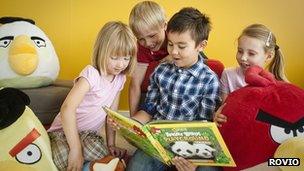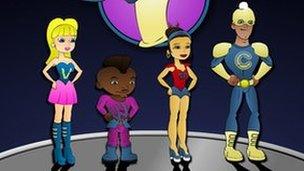Angry Birds game fires into the classroom
- Published
Click discovers how both Minecraft and smiling can help in the classroom
From Angry Birds to Minecraft, computer games are invading the classroom. But this is not going on behind the teacher's back anymore: it is part of the lesson plan.
The average young person will have spent 10,000 hours gaming by the time they are 21 years old, research suggests., external
This has been mainly for entertainment, providing light relief from the maths textbooks and science experiments taking place in classrooms. But gaming is taking up more time of a child's life.
For a child in the US with perfect attendance, 10,080 hours will be spent in school from fifth grade (age 10) to high school graduation, according to game designer Jane McGonigal., external

Minecraft is just one game that has found its way into the classroom, actually being used in lessons
In the UK, computer games offering "stealth learning" have been used by many schools, external. But the big developers have generally, so far at least, not been keen to get involved.
Angry Birds creator Rovio has brought Angry Birds Playground, a schools initiative devised with the University of Helsinki in Finland, into the kindergarten classroom of children, aimed at six-year-olds.
With the initiative already in use in Finland, Rovio has now entered into an agreement with schools in China.
"With small children, the Finnish approach to education is very much play-orientated," says Sanna Lukander, vice president of book publishing at Rovio Entertainment.
"These characters and their world seemed to inspire children. You can't not think about how you might motivate children to do more than play."
Finland is rated as having the best education system in the developed world.
And it is not just the same edition of Angry Birds re-packaged: it is using the now-famous characters in new education-based games and a "full 360-degree approach to learning" involving books, teachers and digital devices.
But what is it that children can learn from computer games which can really help with the hard learning needed in the classroom?
"Games have a larger effect on learning than traditional materials in particular areas, like language acquisition, science, mathematics and social studies," says games scholar Professor Constance Steinkuehler, a former White House analyst.
"It's not just making the game, it's then about going back and assessing it - is it having the impact and educating in the way you hoped?
"If you're talking about games in the classroom, games aren't the only vehicle for learning. You have a teacher, you have peer interaction and a structure of activities, that all plays a role, whether it's productive or whether it's rubbish.
"It's just like giving a textbook - you can have a fabulous one you can do great stuff with or not."
And Rovio is keen to point out that it is not just the games having an impact in the classroom.
"Angry Birds Playground is not an educational game, it's an educational environment," says Ms Lukander.
"We couldn't put Angry Birds stickers on learning and just export it. It's a lot of careful R&D and research. It's been in the works for two and a half years."
What this means is more than just using a slingshot to launch birds at pigs.
Cool vegetables?
Rovio has already worked with the publishers Penguin, National Geographic, Nasa, the National Geographic and others on educational books. It is not even branding itself as a games company but as a media company,
But it is not the only media company in educational games.

Rovio says it advocates digital technology as part of the teaching process but it is not the only answer
At the more avant garde end of games aimed at educating children, there are shooting games attempting to make chewing vegetables seem cool, external right through to combating sexually transmitted infections , externalwith a choice of superhero characters like Willy the Kid.
Yes, really.
More widely, Minecraft, the virtual world game, is being used in classrooms in all sorts of innovative ways.
"Minecraft is one of the most important games for learning right now," says Prof Steinkuehler.
"What kids are doing with Minecraft is mind-blowing. It's just amazing."
In a classroom at Reykjavik University in Iceland, just like many others, Minecraft is used as a 3D graphical interface to help young people understand the basics of telling a computer what to do.
According to MinecraftEdu, which is working with around 1,000 schools, the game is being used in every subject area across all school age groups, providing digital building blocks of what a lesson can demonstrate and teach.
'Coercive' gaming
But interestingly, Minecraft is blocked by a number of school firewalls.
And there are those who think games in the classroom do more harm than good.
"Gaming in the classroom might be frivolous at worst or entertaining at best," says teacher and author Dr Gary Stager.

Computer games have been developed to cater for all sorts of different educational challenges
Current systems of education, Dr Stager argues, are seen as "unpleasant, tortuous and create a league table of winners and losers". But games in the classroom are not the way to fix it.
"The games developed for education tend to be a lot less fun, interesting and merely test prior knowledge," he says.
"Worst of all, they're coercive. Adults are taking something kids love - games - and using them in a coercive fashion to deliver curriculum."
But the technology companies working with children see the move towards gaming and technology as inevitable. LeapFrog's LeapPad2 tablet device was one of the best-selling toys last year.
"Children already live in a multi-screen environment," says Sally Plumridge, LeapFrog's international marketing director.
"The whole world they work in is much more interactive. Bringing gaming into their lives really allows them to develop those cognitive skills."
"There's still a need to learn in a traditional way; however, the way that traditional learning extends into new technologies just gives a different dimension to education and a more practical dimension.
"Children develop in role play and looking what their parents do. From a very early age, they see their parents with tablets and phones.
"Their instincts in that world of what to do and when to do it are much more enhanced than our own. We're learning it and they're growing up with it."
Perhaps that is why so many parents look to their children for help when their phone stops working - they've spent 10,000 hours on these devices before they turn 21.
- Published7 September 2013
- Published3 April 2012
- Published14 May 2013
- Published4 September 2013